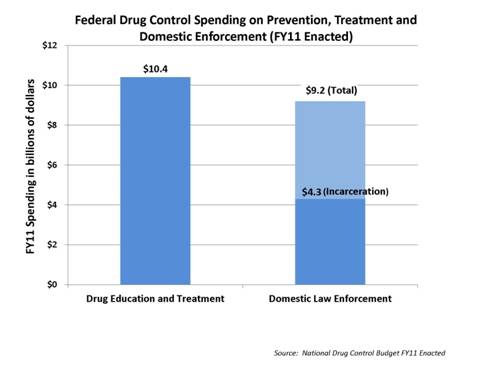
Compared to their representation among the U.S. population, African Americans are disproportionately incarcerated for drug offenses. These two groups have consistently higher proportions of inmates in state prison who are drug offenders compared to whites - about 50% higher.
Over the past two months, we have met with African American leaders across the country – in Chicago, Philadelphia, New York, Atlanta and Los Angeles – to listen to what they had to say. We discussed their concerns and ideas, and we outlined the Obama Administration’s approach to drug policy, presenting our view that it is guided by three indisputable facts: Addiction is a disease that can be treated; people can recover from drug addiction; and new interventions are needed to appropriately address substance abuse and drug-related crime. Simply put: We cannot arrest our way out of our Nation’s drug problem.
Addressing drug addiction as a public health issue will help us break the cycle of drug use, crime, and incarceration. And in keeping with a balanced public health and safety approach, the Obama Administration is taking unprecedented actions to restore balance to how we address our Nation’s drug problem and its disproportionate effects on communities of color. As Director Kerlikowske has said, the “War on Drugs” metaphor is not something that captures the complexity of the problem, or our innovative response:
- This last fiscal year, the Obama Administration spent $10.4 billion on drug prevention and treatment programs compared to $9.2 billion on domestic drug enforcement;
- In August of last year, President Obama signed the Fair Sentencing Act into law that dramatically reduced a 100-to-1 sentencing disparity between powder and crack cocaine, which disproportionately affected minorities;
- The Administration also advocated for, and the U.S. Sentencing Commission approved, the retroactive application of these sentencing guidelines which became effective on November 1st.
- We are supporting the expansion of drug courts, which place roughly 120,000 non-violent drug offenders into treatment instead of prison each year;
- The Administration is implementing the Second Chance Act, which passed Congress with overwhelming bipartisan support and provides resources for common sense, evidence-based approaches to reducing crime;
- The Administration has worked to clarify rules regarding the eligibility of housing authorities to allow ex-offenders access to public housing and ensure that they understand that they have the discretion to lease to all but two types of criminal convictions: Individuals convicted of manufacturing methamphetamine in public housing and registered sex offenders; and
- Attorney General Holder has also contacted State Attorneys General to urge them to review the legal collateral consequences of their State laws being placed upon ex-offenders that may burden their successful reentry into society.
The Obama Administration is also supporting additional innovative new programs that show great promise in extending our approach to criminal justice reform and alternatives to incarceration:
- The Drug Market Intervention program. This community-based diversion strategy has shown tremendous promise in disrupting open air drug markets by directly engaging drug dealers, their families, and communities by creating clear and predictable sanctions, offering a range of community services including drug treatment, and improving community-police relations. Jurisdictions that have implemented this strategy have experienced decreases in drug crime and other crimes without displacement of the drug market activity into other neighborhoods
- Hawaii’s HOPE Probation program (Hawaii's Opportunity Probation with Enforcement). This program reduces probation violations by drug offenders and others at high risk of recidivism. Probationers in the program receive swift, predictable, and immediate sanctions - typically resulting in several days in jail - for each detected violation, such as detected drug use or missed appointments with a probation officer. Evaluation results indicate the program is highly successful at reducing drug use and crime, even among difficult populations such as meth users and domestic violence offenders.
According to a recent survey, African American parents now consider youth drug use as the top concern for young people, ranking higher than gun related crimes, school violence, or bullying. We look forward continuing leading the Federal government’s collaborations with the African American community to reducing disparities and ensure that we can prevent drug use before it starts and work together to break the cycle of drug use and crime.
Additional resources:
- U.S. Drug Control Policy (National Drug Control Strategy)
- Drug Market Intervention program
- Hawaii’s HOPE Probation program
- ONDCP’s work to reform the criminal justice system
- Alternatives to incarceration
- Drug and Veterans Courts
- In-Custody Treatment and Recovery
Rafael Lemaitre is Associate Director for Public Affairs, Office of National Drug Control Policy


